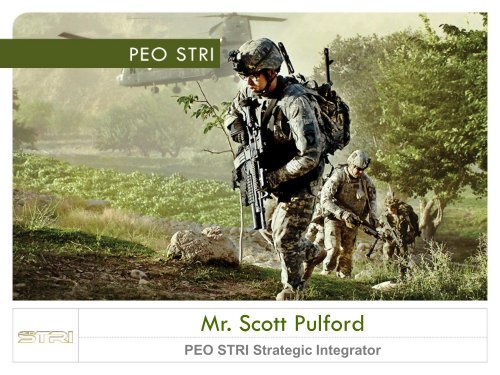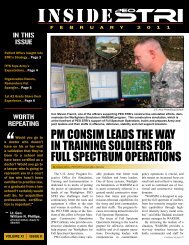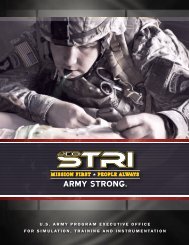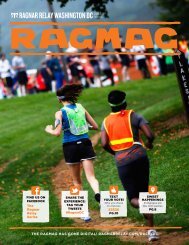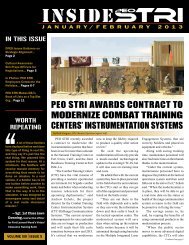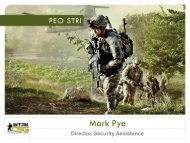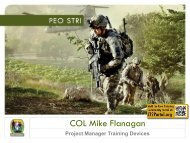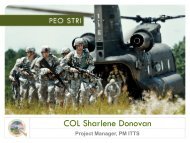Mr. Scott Pulford - PEO STRI
Mr. Scott Pulford - PEO STRI
Mr. Scott Pulford - PEO STRI
Create successful ePaper yourself
Turn your PDF publications into a flip-book with our unique Google optimized e-Paper software.
<strong>Mr</strong>. <strong>Scott</strong> <strong>Pulford</strong><br />
<strong>PEO</strong> <strong>STRI</strong> Strategic Integrator
Purpose<br />
Purpose / Agenda<br />
• Provide industry with insight into ongoing challenges and changes across the Army Training Support<br />
System Enterprise (TSS E).<br />
Agenda<br />
• TSS Program Banding Methodology – UPDATE<br />
• TADSS Quality Improvements<br />
• Army Leadership Decision Making Forums and How They Fit Together – UPDATE<br />
• How Resources Flow to <strong>PEO</strong> <strong>STRI</strong><br />
• CAC-T “Wicked Problems”<br />
83
What It Means<br />
TSS Program Banding Methodology<br />
Army leadership from across the Training Support System (TSS) Enterprise continues to refine its<br />
prioritization methodology to define Requirements for each of the TSS programs funded by the Army G3.<br />
This Banding Methodology is used to allocate TT PEG funding to programs.<br />
Band 0 - Statutory / must fund TSS requirements.<br />
Band 1 - Sustain TSS Services.<br />
Band 2 – High Risk Products – part of prescribed training strategy and not fielded to a sufficient quantity<br />
(
TSS Program Banding Methodology<br />
Why You Care<br />
The banding methodology will drive how much funding each program receives as a part of the POM<br />
process. Lower priority programs may only have sufficient funding to maintain a reduced level of<br />
government project team oversight for the effort.<br />
Possible that lower band programs may not have funding to execute contract actions with industry.<br />
Potential for impacts to contract solicitations.<br />
Way Ahead<br />
The Fall Training General Officer Steering Committee (TGOSC) reviews the program banding annually<br />
and will make adjustments to program priorities that will inform funding decisions for Budget and POM<br />
years.<br />
<strong>PEO</strong> leadership may conduct Configuration Steering Board reviews on programs to descope<br />
requirements to address affordability challenges.<br />
83
What It Means<br />
TADSS Quality Definition<br />
Goal: A clear definition by which to measure the TADSS’s relevance, complexity, currency, and overhead<br />
to efficiently and effectively meet Commander Training needs.<br />
1. Relevance (Suitability): The TADSS are relevant to latest training concepts and strategies. Do the<br />
TADSS's available allow Soldiers and Units to train to employ “the system's” full capabilities in an<br />
Operational Environment?<br />
2. Complexity (Trainability): The TADSS are easy to use (e.g. minimum number of performance steps,<br />
uses automated feedback, doesn't require excessive memorization etc.). There is little to no unit<br />
training time required to prepare a TADSS for training, place into action, and is simple to maintain.<br />
The TADSS maximizes training skill retention and provides sufficient variance in scenarios or task<br />
presentation to build expertise over time.<br />
3. Currency: The TADSS reflect the capabilities of Soldier or Unit Equipment in such a way as to meet the<br />
training task and ensure “minimal” negative training transfer as a result of using the TADSS.<br />
4. Overhead (Sustainability, Reliability): The TADSS design minimizes fixed (other than unit<br />
manpower and facilities) and variable (expendable supplies) expenses required to plan, prepare,<br />
execute, and assess training. Minimum contractor support required.
TADSS Quality Definition<br />
Why You Care<br />
TSS Banding Methodology will drive program investment decision – Quantity Production vice Qualitative<br />
Improvements to fielded capabilities.<br />
Quality improvements may create alternative contracting strategies and opportunities.<br />
TRADOC is expressing a growing emphasis on reducing dependency on contractor support / operators<br />
and moving towards Soldier operators / Borrowed Military Manpower.<br />
Way Ahead<br />
Programs will align future investment and contracting strategies IAW TRADOC priorities and overall<br />
banding methodology. There may be adjustments from year to year on those priorities.<br />
Changes to Training Strategies, Force Structure and Weapon System configuration will all impact program<br />
investment plans for the future.<br />
83
What It Means<br />
Army Training Decision Points<br />
Senior Army Leadership uses multiple forums to make strategic decisions relative to programs, resources<br />
and priorities.<br />
In FY13-14 the Army will continue it’s review and refinement of proponent / Center of Excellence Training<br />
Strategies (TSSRs) and will balance those strategies against our TADSS portfolio to determine if<br />
adjustments are needed for:<br />
Why You Care<br />
Location / allocation of TADSS<br />
Training capabilities those TADSS provide<br />
Overall quantity of TADSS required<br />
TAA 14 and changes<br />
to Army Force<br />
Structure will impact<br />
overall requirements<br />
“Quality”<br />
Improvements to<br />
fielded enablers<br />
<strong>PEO</strong> <strong>STRI</strong> anticipates that the 1 st QTR FY14 TGOSC will make adjustments to the Banding Methodology<br />
to account for the revised Training Strategies developed by the proponents. Strategies may drive<br />
increased TADSS utilization (prescriptive use) or additional capabilities required.<br />
83
Army Training Decision Points<br />
Way Ahead<br />
All roads lead to TGOSC 14-01. TGOSC 14-01<br />
Banding<br />
Methodology<br />
Revised<br />
Initial POM 16-20<br />
Planning<br />
Mid-Year Review<br />
TGOSC 13-01<br />
Banding<br />
Methodology<br />
Updated<br />
1<br />
Sequestration Drills<br />
POM 15-19 Build<br />
2<br />
POM 16-20 Build<br />
5<br />
Combat Support /<br />
Combat Service<br />
Support TSSR<br />
Furlough<br />
TSWG Executive<br />
Session<br />
POM 15-19 Results<br />
delayed to late JUL<br />
TSSR – Training Support System Review<br />
ATS III – Army Training Summit III<br />
POM – Program Objective Memorandum<br />
TGOSC – Training General Officer Steering Committee<br />
TSWG – Training Support Working Group<br />
4<br />
3<br />
83
What It Means<br />
How Resources Flow<br />
<strong>PEO</strong> <strong>STRI</strong> receives funding from three primary sources: 1) DA G3 (Direct Mission Programs), 2) DA G8 /<br />
Other <strong>PEO</strong>’s / PM’s (Support Mission Programs), and 3) USASAC (Foreign Military Sales).<br />
Army level decisions directly impact program and contracting strategies executed by <strong>PEO</strong> <strong>STRI</strong> PM’s.<br />
Why You Care<br />
Extended Continuing Resolution and Sequestration are going to impact FY14 and beyond.<br />
Timing of contract awards impacts the “vulnerability” of program dollars when viewed externally. Each<br />
Appropriation of funding has a “shelf life” along with OSD goals for execution.<br />
OMA – 1 Year Funding – Must be 80% obligated by start of 4 th QTR<br />
RDTE – 2 Year Funding – Growing emphasis on disbursement of funds after contract award<br />
OPA – 3 Year Funding – OSD Goal is to be 80% Obligated by the end of year 1<br />
Way Ahead<br />
CRA and Sequestration along with Mid-Year Reviews of Execution will create challenges for programs.<br />
On 10 May PM’s received their FY13 OPA funding.<br />
On 13 May <strong>PEO</strong> <strong>STRI</strong> received datacalls for FY13 Mid Year Review.<br />
83
How Resources Flow<br />
1<br />
FY XX POM Built 2 ½ Years Prior<br />
FY XX<br />
- No New Starts<br />
- Prgm Funding<br />
limited to lower of:<br />
1) Current FY with<br />
marks<br />
2) Prior year<br />
enacted $ amt<br />
2<br />
Support Mission<br />
(EE PEG)<br />
CRA<br />
Direct Mission<br />
(TT/EE PEG)<br />
Budget Passed<br />
3<br />
4<br />
Contract Award<br />
80/20<br />
Delivering Capability<br />
- Sustainment OMA<br />
- Life Cycle Reqmts<br />
6<br />
Contract Award<br />
5<br />
Reimbursable (<strong>STRI</strong> Labor & Travel)<br />
7<br />
FY13 Challenges<br />
- Sequestration<br />
- Furlough
What It Means<br />
CAC-T Wicked Problems<br />
CAC-T has identified several “Wicked Problems” that negatively impact Soldiers, Units and Commanders<br />
from achieving their training objectives. Two of these problems are of significant importance to the <strong>PEO</strong>:<br />
1) Improvements to training scenario initialization (cost, schedule and complexity). Several key training<br />
enablers require extensive preparation time, personnel and other resources to initialize a training<br />
event. The goal is to shorten / reduce those initialization resource demands.<br />
2) Provide training solutions that readily integrate into the ITE or Blended training construct.<br />
a. e.g. Provide capabilities that would allow an individual Squad to train in a complex, immersive<br />
environment while nested within a larger Brigade level event without the Squad becoming a<br />
training aide.<br />
Why You Care<br />
<strong>PEO</strong> <strong>STRI</strong> views these capability enhancements as critical to supporting the Army’s Training Strategy at<br />
both Home Station and Combat Training Centers.<br />
Providing these types of capabilities would add value to future proposed solutions.<br />
Way Ahead<br />
CAC-T and <strong>PEO</strong> <strong>STRI</strong> will continue to emphasize / prioritize solutions to these qualitative improvement<br />
challenges from our users.<br />
83


